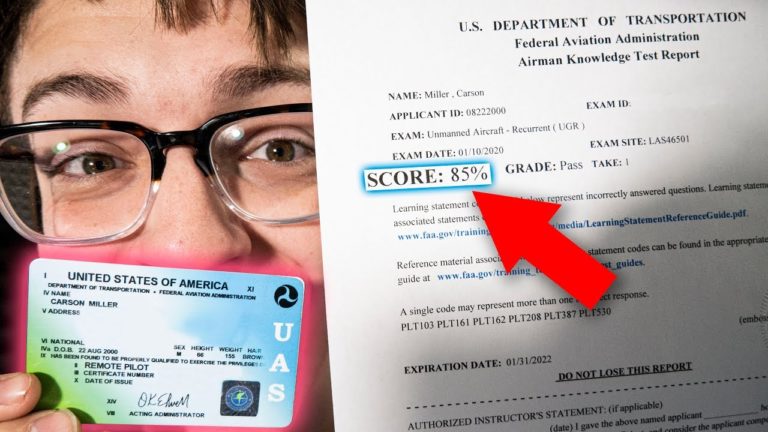While anyone can pass the Part 107 exam, it’s not always as easy as you might think. Some aspiring professional remote pilots get lulled into a false sense of security by thinking they can memorize answers from Part 107 practice tests and easily pass. You don’t want to be that person who ends up failing your Part 107 exam.
That’s because the FAA has a few tricks up their sleeves, including new questions, questions that could tempt you into thinking there are multiple right answers, and more. Don’t be that person who falls for a few little tricks that, when added up, can make the difference between a pass and a failure. You don’t want to have to take the test again after a failure.
With that said, here are the 5 most important things to remember when you’re studying for the Remote Pilot exam — and for when you sit down at the testing center for the real thing:
1. You will see new questions on the Part 107 exam
Perhaps the biggest shock to test takers are the questions that appear to come out of the blue. You’ve never seen anything like these questions in your studying, and at first glance you may wonder if you’re taking the correct test.
Every Remote Pilot exam includes a handful of these questions. They change all the time and aren’t found in any public database. They serve to test your application of the rules, not just your memorization of them.
The FAA teaches that there are four levels of learning – Rote Memorization, Understanding, Application, and Correlation. They test for a minimum level of Application.
Rote Memorization is when you take practice tests over and over until you can get a passing score because all you’re doing is memorizing the correct answers. Application is when you gain a deeper knowledge of the rules and know why those answers are correct. The FAA wants you to know what to do in every situation, not just the ones in practice test questions.
For some, this level of learning may come from reading a study book. For others, a proper Remote Pilot test prep course with an FAA-certified instructor is what it takes.
Unfortunately, for hopeful remote pilots who bank on only memorizing answers, these questions make the difference between passing and failing your Part 107 exam. But if you’re properly prepared – you understand the why and how – these questions shouldn’t concern you.
2. Read the full question
Some tricky Remote Pilot test questions test your impulsivity, and it all comes down to answering the question without either reading the full question or reading all the answers.
There’s no reason to move through the test so fast. Take your time! You have two hours on the initial Remote Pilot Test, which is enough time to go through the entire thing at least twice.
Read the entire question, understand what it’s asking, and then read every single answer. Even if you know the answer before seeing your options, still read every single answer before marking one.
Spending an extra few seconds on each question is a worthwhile time investment. You won’t have to come back and take the Remote Pilot test a second time after failing by one question because you rushed.
3. The most correct answer
There are some questions that you could argue have two correct answers. And you wouldn’t be wrong! But don’t read into the question too much. Choose the most correct answer.
For example, a question may ask:
As the Remote PIC, when may you fly your sUAS out of your visual line of sight?
1- Never.
2- When utilizing a Visual Observer.
3- When proper risk management has been conducted.
You may be tempted to answer any of these, because any of them could be correct in different scenarios. #1 would be correct when you don’t have a V.O. or waiver, but that’s not what the answer says. #3 is correct only if you’ve gone through the waiver process, but again, the answer says nothing about a waiver. Only #2 is correct with the information given, with regards to the basic Part 107 regulations.
Another way that this concept can trick people on their Remote Pilot exam is confusing recreational flying versus flying under Part 107. There are some differences in the two sets of rules; remember what you learned in your Part 107 training and that you’re taking the Part 107 test. There is no, but if I were flying recreationally… when you’re considering your answers!
4. Use the Test to pass the Test
Use that Sectional Chart Legend in the beginning of your test supplement booklet. When you go into the test, the test proctor will issue you a booklet with charts and figures that you’ll reference for the test. But most students don’t know there’s a legend in the beginning. Afraid you’ll miss a question because you can’t remember what Class B airspace boundaries look like? It’s in your booklet! Many chart-reading questions have little hints in your test booklet.
5. Look through the other questions for answers to tricky ones
You may find that one question may answer another one. For example – and this is a really basic example, but it illustrates the point – you may be stumped by a question that asks, how high above the ground are you normally allowed to fly your sUAS? A few questions later you may see, when are you allowed to fly your sUAS above 400’ AGL?
Skip these questions if you’re not sure of the answer. Mark them as incomplete. When you’ve gone through the test the first time, go back to those incomplete questions. You may have seen something later on in the test that jogged your memory for that first incomplete question, and now you know the answer!
You don’t need to worry about failing your Remote Pilot exam!
Knowing how the Remote Pilot exam can trick you, and how to handle those tricks, will definitely give you some breathing room. It could make all the difference between a 68% (which means failing your Part 107 exam) and a 70% (the minimum score you need to pass your Part 107 exam). With proper training, some practice, common sense and taking it easy, you can become a certified Remote Pilot on your first attempt!
John Peltier





